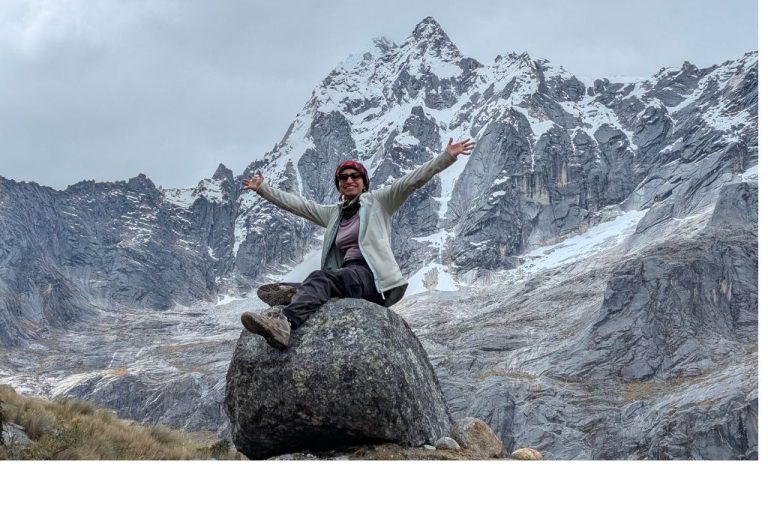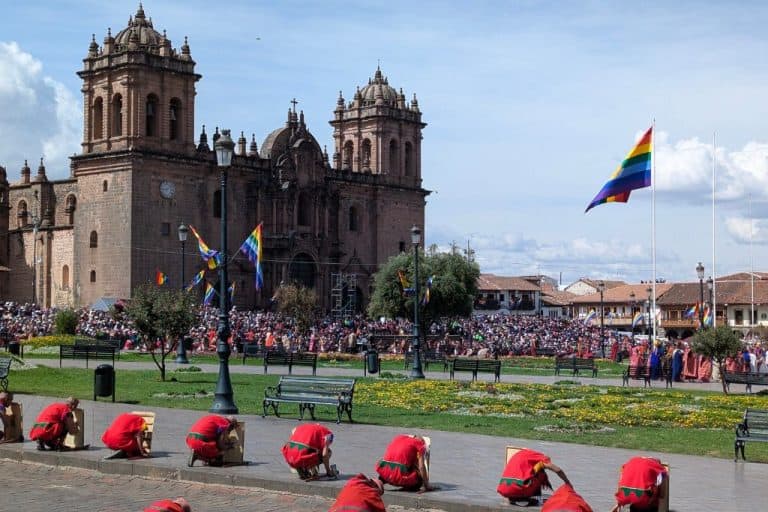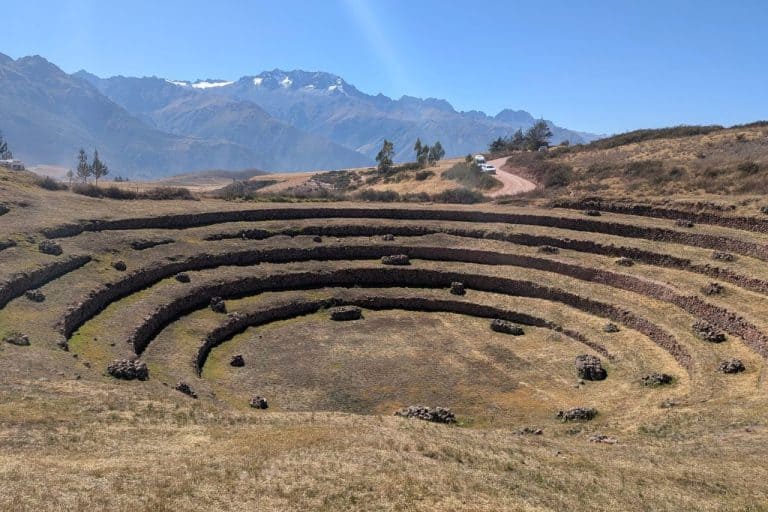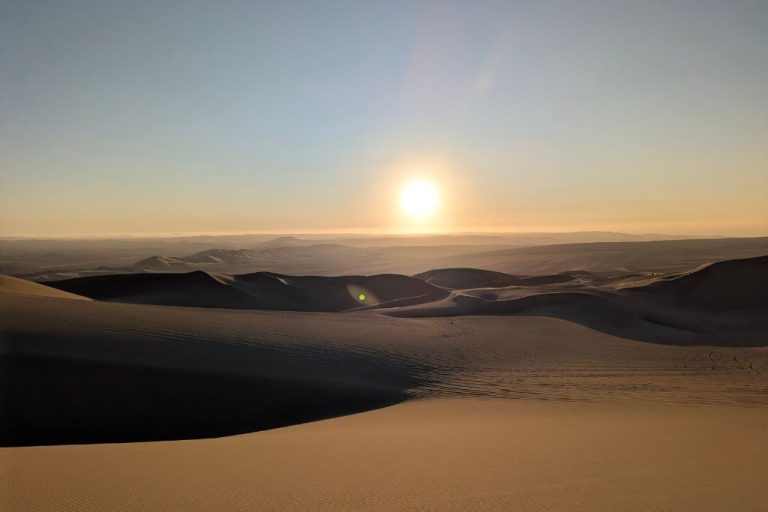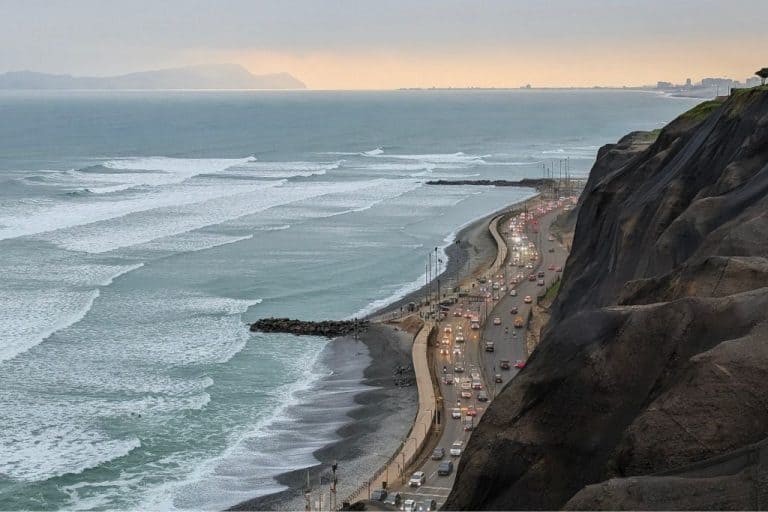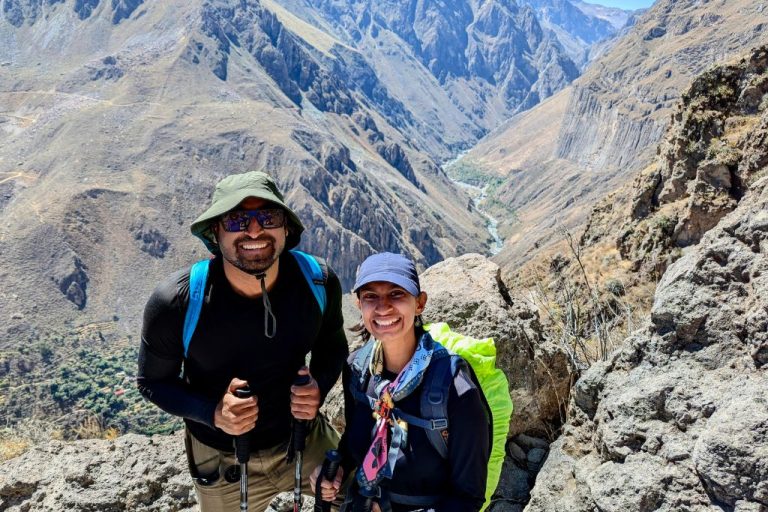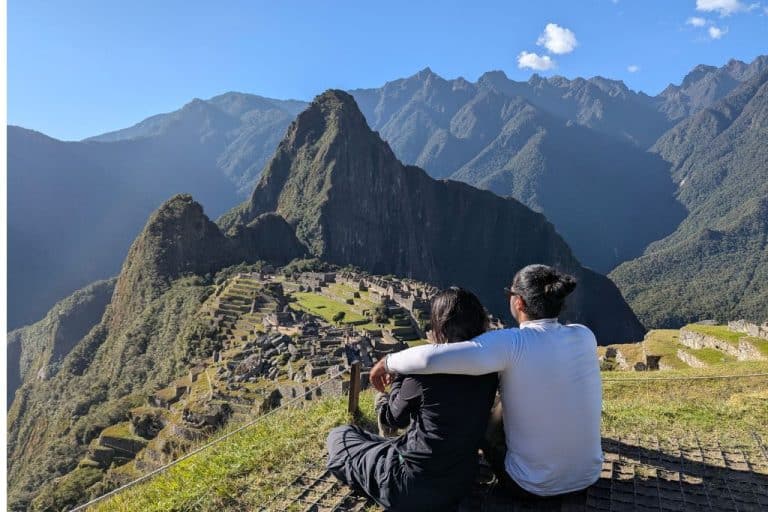Ollantaytambo Travel Guide: All You Need To Know
We traveled across Peru for three months, staying in Cusco for a full month – and even that wasn’t enough to see everything. Between working from our laptops and soaking in the city’s energy, time just flew by. But there was one place that really stood out for us – Ollantaytambo, or as locals fondly call it, Ollanta.
We first discovered this charming town during a day trip to the Sacred Valley with Machu Picchu Reservations. Like most tours, it included a stop at the Ollantaytambo ruins. The site was spectacular, but the visit was rushed – the kind where you’re constantly checking the time and wishing you could stay longer. The vibe of Ollantaytambo, however, left a mark on us. It felt calm, colorful, and alive.
The second time we visited Ollantaytambo was for our Inca Trail hike to Machu Picchu.
So when we wrapped up our time in Cusco, we decided to return – and this time, we stayed for two weeks.
It was one of the best decisions of our trip.
Why Visit Ollantaytambo
Ollantaytambo isn’t just another stop on the way to Machu Picchu. It’s one of the few living Inca towns in Peru – meaning people still live in the same narrow, cobblestoned streets that date back to Inca times. The canals that run along the alleys still carry fresh water from the mountains, and traditional Andean houses made of stone still serve as homes, shops, and cafés.
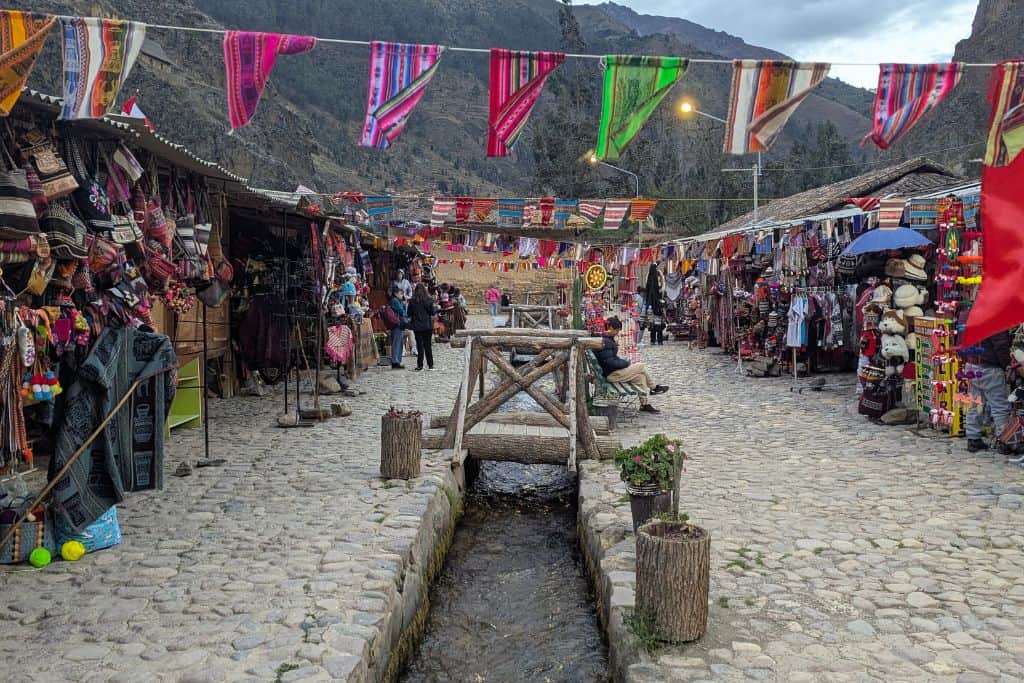
What makes Ollantaytambo special is the balance between history and everyday life. You can explore impressive ruins one moment and sip coffee in a courtyard café the next, watching locals go about their day. It feels authentic. In the morning and afternoon, you see buses coming in to the town and it gets crowded but in the evening when all the tourists leave, it becomes so quiet and peaceful.
The air is fresher here, the mountains surround you from every side, and the slower pace feels grounding after Cusco’s constant movement.
How To Get To Ollantaytambo From Cusco
Ollantaytambo sits about two hours from Cusco, nestled in the heart of the Sacred Valley. Getting there is easy – and depending on your travel style, you can either make it a day trip or, like us, stay for a while to really experience the place.
Collectivo (Shared Van or Taxi)
This is the most common and affordable way to reach Ollantaytambo. Head to Salidas a Ollantaytambo on Avenida Grau and Calle Pavitos in Cusco, where you’ll find vans and shared taxis heading toward the Sacred Valley. Drivers and helpers often call out “Ollantay!” to attract passengers.
For around 10–12 soles per person, you can choose between a car or a van. We preferred the van – it had more space, and the ride felt smoother on the winding roads.
The drivers usually wait until the vehicle is full before leaving, so expect a 20–30 minute wait depending on the time of day. The best time to go is in the morning when there’s more movement. Once you arrive, the collectivo drops you near Plaza de Armas, right in the center of Ollantaytambo.
The drive is scenic – you’ll pass through small villages, open farmland, and see the Andes rising in every direction.
Hiring a Private Driver
If you’re traveling as a group or have luggage, hiring a private driver can be convenient. It’s more expensive, but you get the flexibility to stop along the way – perhaps at Chinchero, Moray, or the Maras Salt Mines.
This option also makes sense if you’re catching a train from Ollantaytambo to Machu Picchu and want to travel at your own pace.
Things To Do In Ollantaytambo
Despite being small, Ollantaytambo has plenty to keep you engaged. It’s a town where you can easily fill your days – whether you’re hiking, eating, or just sitting by the plaza watching life unfold.
Explore the Ollantaytambo Ruins
The main archaeological site is one of the most remarkable Inca ruins in the Sacred Valley and is included in the Boleto Turístico (Tourist Ticket). The terraces rise steeply up the hillside, and as you climb each step, you can feel the weight of history in every stone.
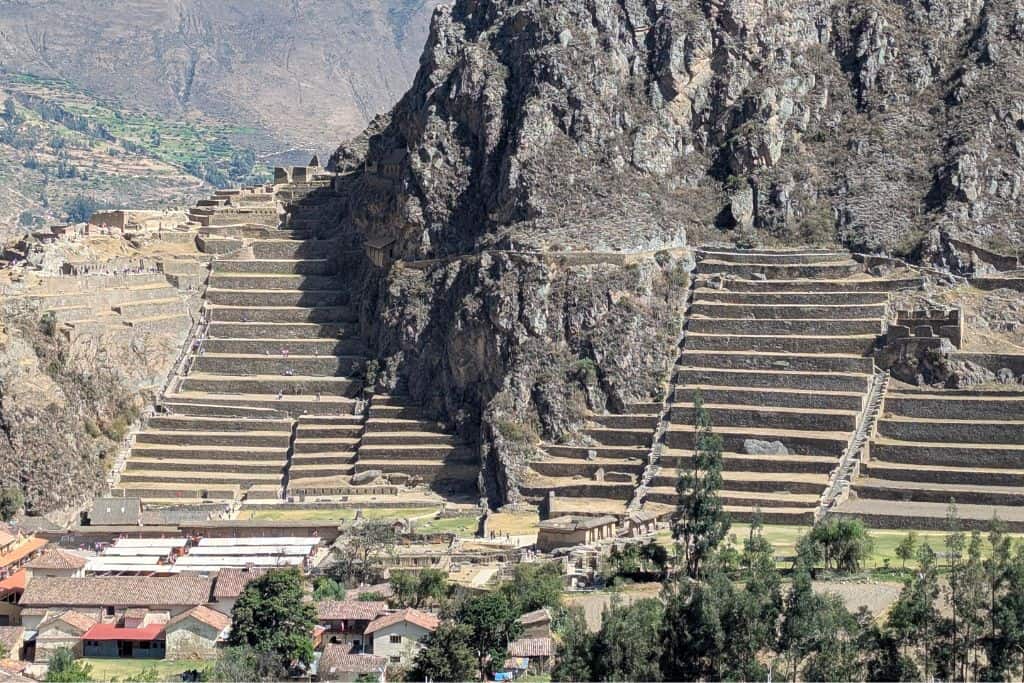
What fascinated us most was how precisely engineered everything was – massive stones perfectly aligned, some weighing over 50 tons. From the top, you get a complete view of the site itself, with the surrounding mountains framing the valley beautifully.
Go early in the morning or late in the afternoon to avoid the crowds. The light at these times also makes for beautiful photos.
2. Hike to the Pinkuylluna Granaries
On the opposite side of the town, you’ll see ancient Inca storage houses built into the mountain – these are the Pinkuylluna ruins. It’s a short but steep hike that rewards you with great views of Ollantaytambo and the archaeological site across the valley.
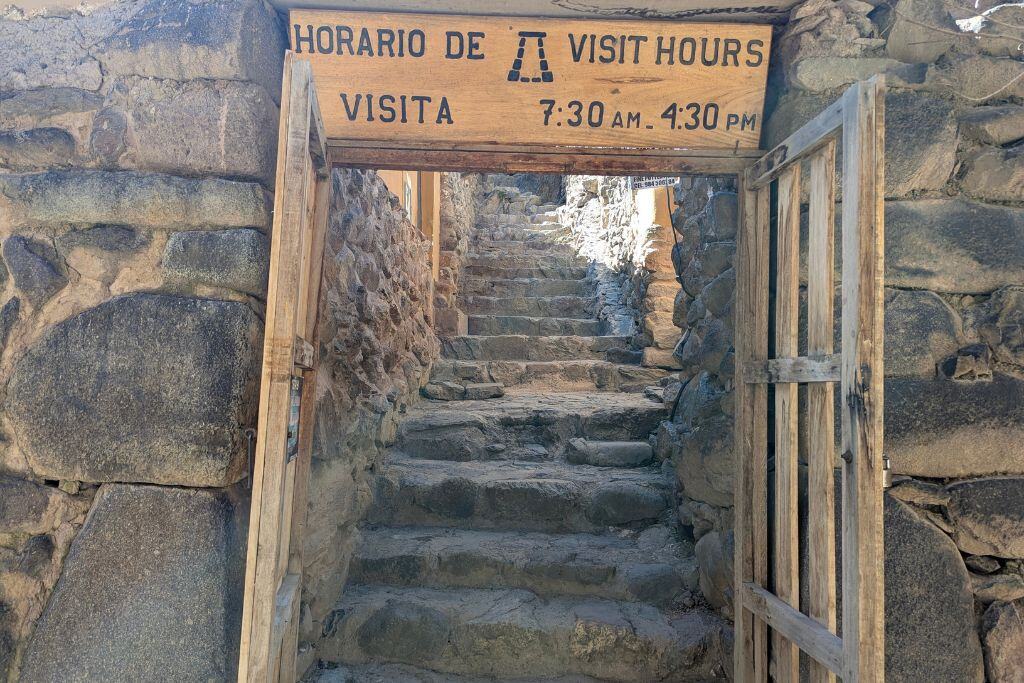
The trail starts near Kamma Guest House. You will see an entrance when you arrive. It should take between 30-45 min to hike up. The trail is steep and uneven, and there are a few steep sections with wooden railings. Some of these railings are a bit unstable, so avoid leaning on them or putting too much weight.
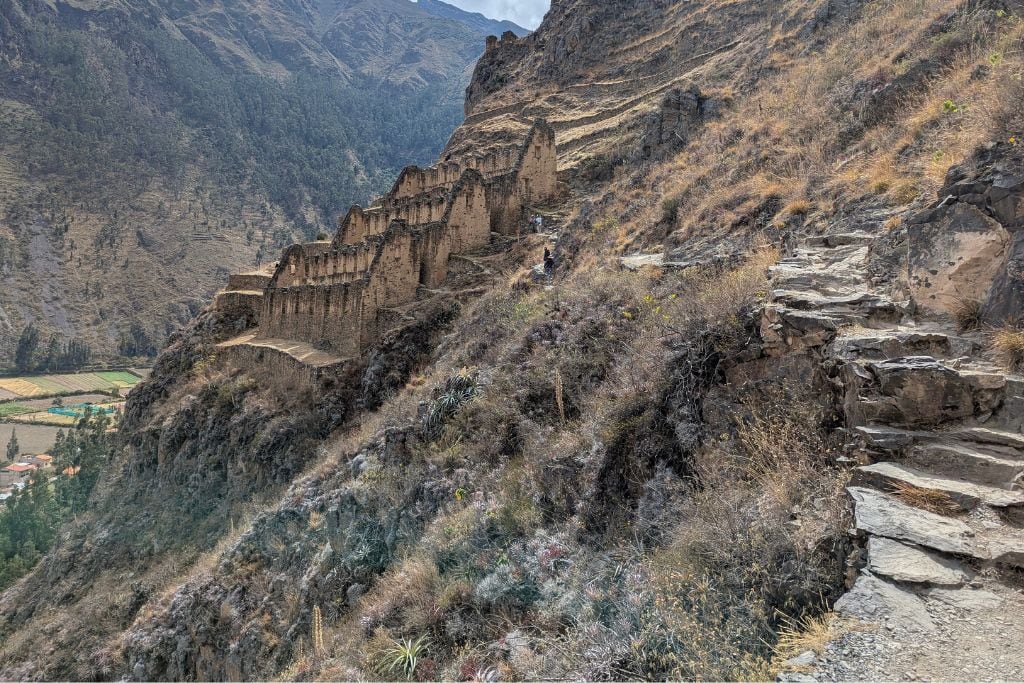
Once you reach the top, take a break and enjoy the view – you’ll be overlooking the town, with stone terraces and rooftops below, and the landscape opening up toward the Sacred Valley.
Carry water and some snacks, especially if you go mid-day – it can get hot. On your way down, take the small detour to another viewpoint where you can see additional ruins. They’re not as impressive, but since it’s a short detour, it’s worth checking out.
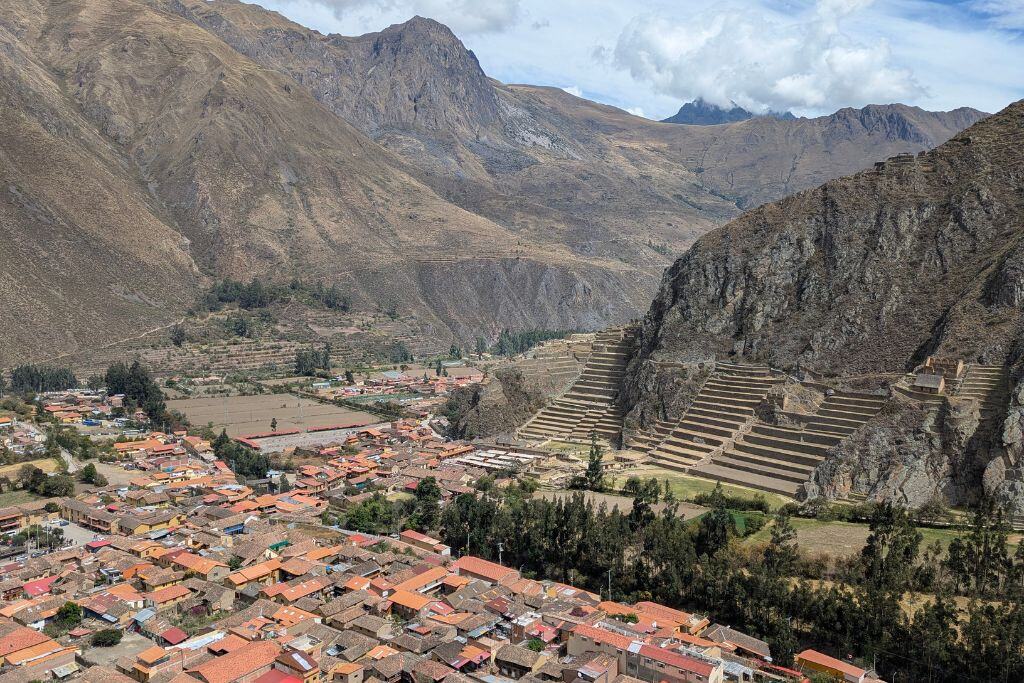
Stroll Through the Town
Ollantaytambo’s charm lies in its streets. Take time to walk through its cobblestoned alleys lined with Inca-era stone walls. You’ll hear the sound of water running through the old canals and see doorways leading to family-run hostels, small eateries, and artisan shops.
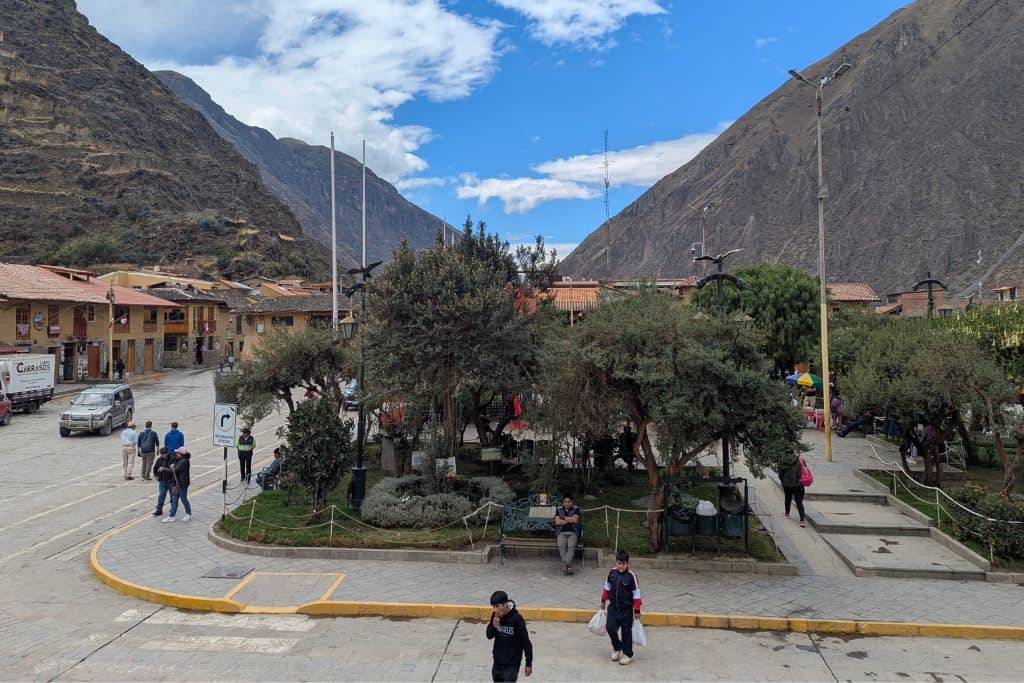
It’s fascinating how modern life continues seamlessly around this ancient structure. You’ll often find people chatting by the canal, kids playing, and travelers quietly exploring.
Don’t rush through the town – it’s a place best experienced slowly.
Visit the Local Market
The mercado just behind the main plaza is small but lively. It’s where locals come for fruits, vegetables, and daily essentials, and it’s also a good place to grab a simple local meal. You can try fresh juices, soups, or vegetarian plates at fair prices. Every Tuesdays there are trucks bringing fruits from the amazon.
Do note, however, that prices here are slightly higher or similar than in Cusco, likely due to transport costs and smaller supply. Bring some cash for small purchases – most stalls don’t accept cards.
Eat Pizza (Seriously!)
We didn’t expect Ollantaytambo to be a pizza haven – but it is! Almost every second restaurant had a wood-fired oven, and the pizzas were surprisingly good. There’s something about sitting outdoors, watching the mountains glow during sunset, with a fresh pizza and a cold drink/refresco on the table.
Whether it’s after a long hike or a relaxed afternoon, pizza in Ollantaytambo just hits differently.

Take Day Trips Around the Valley
If you base yourself in Ollantaytambo for a few days, it’s easy to visit nearby attractions in the Sacred Valley such as Chinchero, Moray, and the Maras Salt Mines. You can hire a driver for the day or join small local tours.
If you plan to come to Cusco, you can also choose to take the option of doing a day tour to Sacred Valley from Cusco and get dropped off in Ollantaytambo.
Each spot offers something different – Chinchero for its weaving and local market, Moray for its circular terraces that look like ancient amphitheaters, and Maras for its striking salt pools cascading down the hillside.
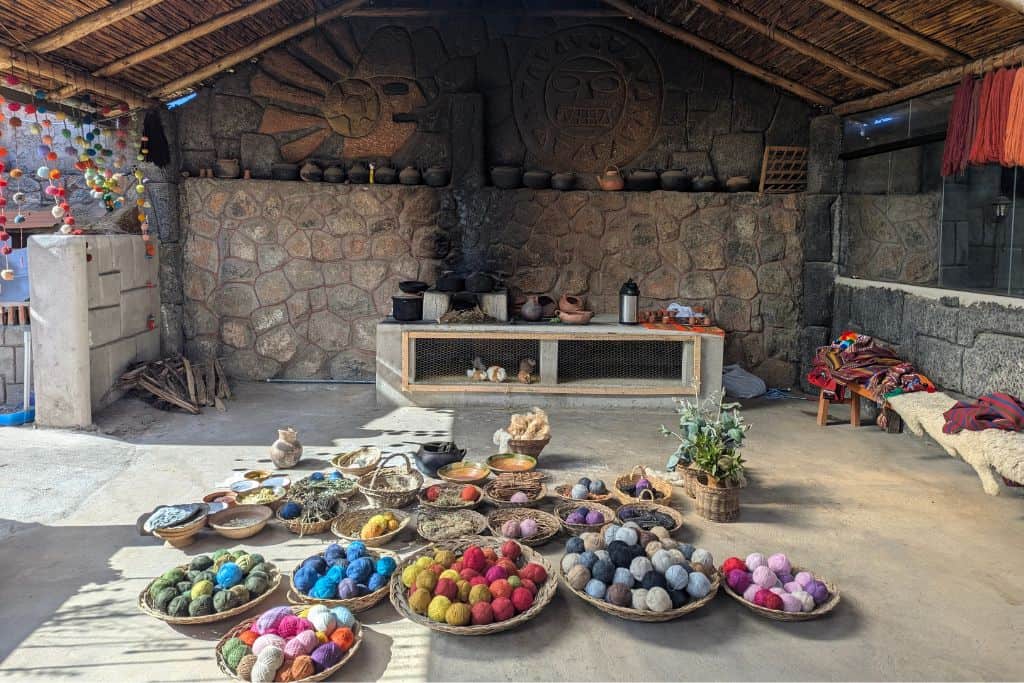
Returning to Ollantaytambo in the evening feels peaceful – quieter, less hectic than Cusco, and surrounded by mountains that fade into soft light at dusk.
Visiting Machu Picchu From Ollantaytambo
If you’re planning to visit Machu Picchu, Ollantaytambo is one of the most convenient bases.
From here, trains run directly to Aguas Calientes (Machu Picchu Pueblo). The journey is scenic – the tracks follow the Urubamba River through lush valleys and towering cliffs. Depending on your budget and timing, you can choose from PeruRail or IncaRail.
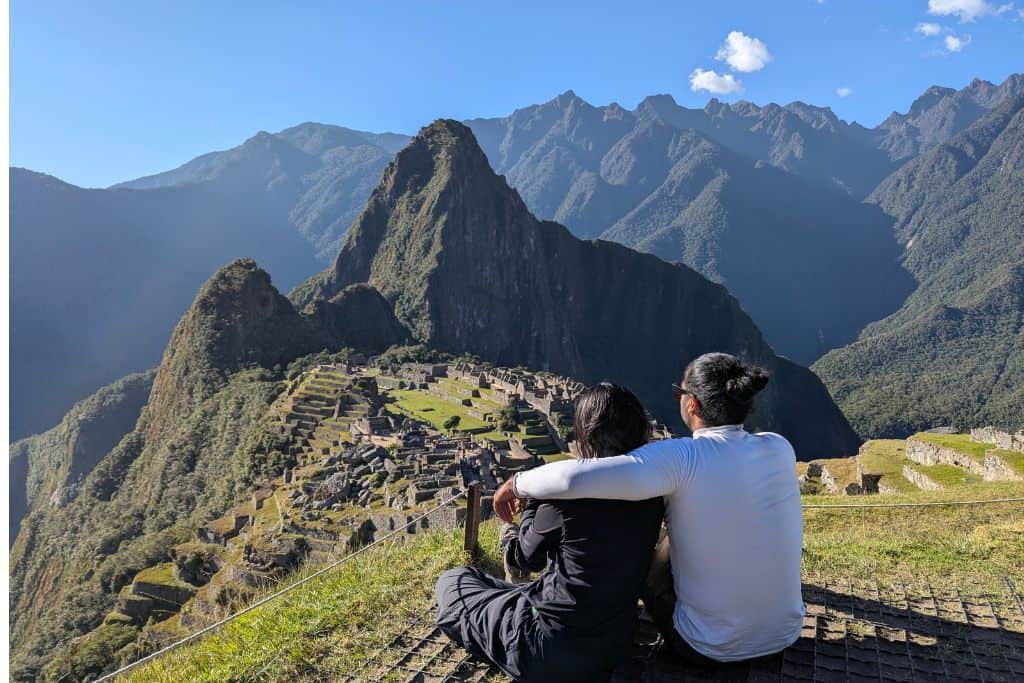
Once you arrive in Aguas Calientes, you’ll take the bus up to Machu Picchu. Tickets can be bought in advance or in town. Some travelers prefer to stay overnight in Aguas Calientes and visit Machu Picchu early the next morning, while others continue their journey onward.
The other option is to book a tour that picks you from your accommodation in Ollantaytambo for a day trip to Machu Picchu.
Where To Stay In Ollantaytambo
Ollantaytambo is a small town and the best place to stay is to be near the main plaza. You will find great hotels and hostels. Since we were working and needed a full kitchen and a private space, we did an AirBnB. However, we heard great things from people staying in the following places:
- Kamma Guest House: An absolutely beautiful place right close to the Pinkuylluna Ruins. The room offers private bathroom and shower and also provides free breakfast!
2. Nuna Sumaq Hotel: They offer a cozy stay in a beautiful hotel with private bathrooms and shower. Also, free breakfast every day!
Are There ATMs In Ollantaytambo?
Yes, there are a few ATMs around the main plaza area, and most restaurants and hotels accept credit cards. You won’t need much cash unless you plan to buy souvenirs or shop at the local market.
Still, it’s a good idea to carry some soles for small vendors, tips, and snacks since not all stalls accept cards.
How Many Days Should You Stay In Ollantaytambo?
If you’re doing a standard Sacred Valley visit, many travelers stay 1–2 nights – enough to explore the ruins and maybe do a short hike. But if you’re slow traveling, working remotely, or simply enjoy being in peaceful mountain towns, you can easily stay a week or two like we did.
Our days found a natural flow – slow mornings with coffee, a short walk or hike before lunch, and quiet evenings spent reading or chatting in one of the cozy cafés. It was a welcome pause between the bustle of Cusco and the adventure of Machu Picchu.
Ollantaytambo vs Cusco – Which Is Worth Staying?
Both Cusco and Ollantaytambo are incredible, but they offer very different experiences. We have heard many people picking one over the other but we believe both places are different and offer different things. It also depends who you are as a traveler and what you want to get from your trip.
- Cusco is energetic, full of history, restaurants, and nightlife. It’s a cultural hub where everything happens – but it can get busy and very touristy (the main plaza).
- Ollantaytambo, on the other hand, feels like stepping into another time. It’s quieter, surrounded by nature, and has a slower, grounded feel. It is at a lower altitude than Cusco, so if you are having issues with altitude then Ollantaytambo can be a good choice.
If you’re short on time, Cusco is a better base for day trips. But if you have a flexible schedule or want a break from the crowds, Ollantaytambo is the perfect escape. For us, staying there for two weeks was one of the most peaceful and grounding parts of our Peru journey.
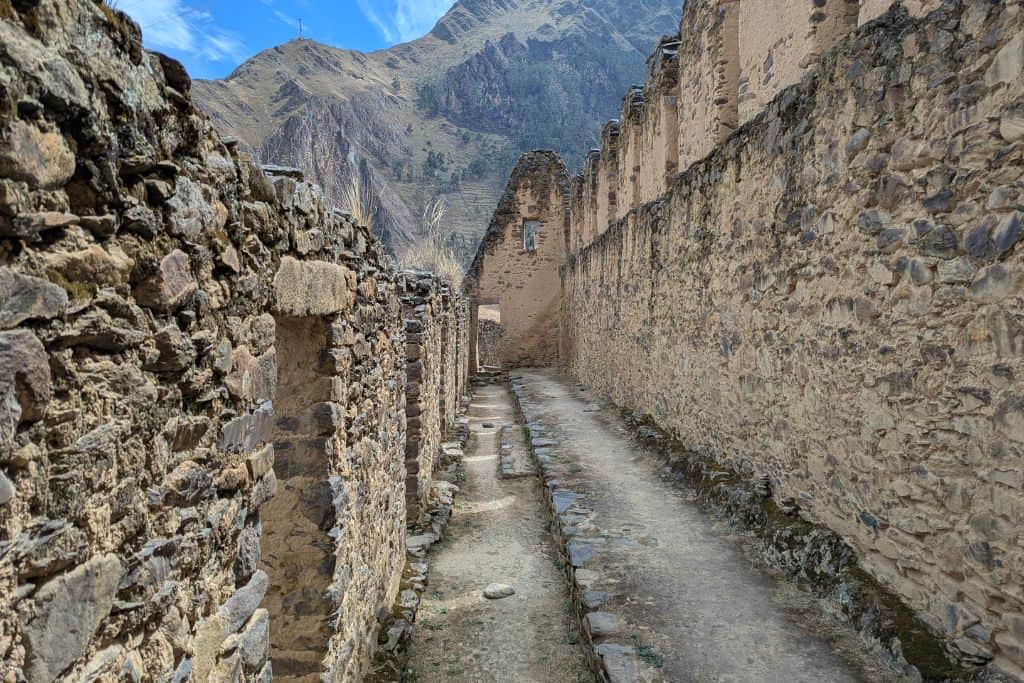
Altitude in Ollantaytambo vs Cusco
One thing we immediately noticed was how much easier it was to breathe here.
Cusco sits at an altitude of 3,400 meters (11,150 ft), while Ollantaytambo is lower – around 2,800 meters (9,200 ft). That 600-meter difference makes a noticeable impact, especially if you’ve been struggling with altitude in Cusco.
Many travelers use Ollantaytambo as a gentler place to acclimatize before heading to higher altitudes or tackling Machu Picchu. The air feels lighter, and it’s a great spot to recover, rest, and still enjoy the Andes without feeling winded after every short walk.
Final Thoughts On Ollantaytambo
Ollantaytambo is one of those rare places where ancient history and modern life blend effortlessly. You’ll find Wi-Fi cafés next to centuries-old walls and locals still walking paths carved centuries ago.
It’s a reminder that travel doesn’t always have to be about checking off landmarks – sometimes it’s about sitting still, watching life unfold, and letting a place sink into you.
We came here for a quick visit, but the town had other plans – it made us stay, slow down, and truly appreciate what a “living Inca town” really means.
This post includes affiliate links, which means that if you make a purchase or booking through them, we may receive a small commission. It doesn’t cost you anything extra, but it helps us keep the blog going. We only recommend products or services that we fully trust.
Read More About Peru
READY TO TRAVEL LIKE A LOCAL?
Book a free 30-minute consulting call with us and let’s start planning your next unforgettable adventure!

